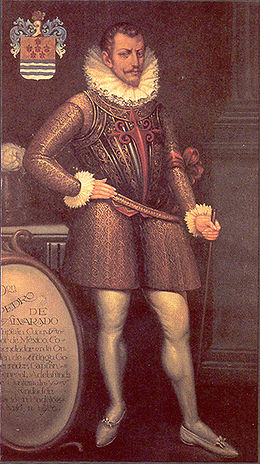
Battle of Acajutla
Encyclopedia

Conquistador
Conquistadors were Spanish soldiers, explorers, and adventurers who brought much of the Americas under the control of Spain in the 15th to 16th centuries, following Europe's discovery of the New World by Christopher Columbus in 1492...
Pedro de Alvarado
Pedro de Alvarado
Pedro de Alvarado y Contreras was a Spanish conquistador and governor of Guatemala. He participated in the conquest of Cuba, in Juan de Grijalva's exploration of the coasts of Yucatan and the Gulf of Mexico, and in the conquest of Mexico led by Hernan Cortes...
and a battalion of Pipiles, in the neighborhoods of present day Acajutla
Acajutla
Acajutla is a seaport and municipality in Sonsonate Department, El Salvador. The town is located at on the Pacific Coast of Central America and is El Salvador's principal seaport from which a large portion of the nation's exports of coffee, sugar, and balsam are shipped. As a municipality,...
, near the coast of El Salvador
El Salvador
El Salvador or simply Salvador is the smallest and the most densely populated country in Central America. The country's capital city and largest city is San Salvador; Santa Ana and San Miguel are also important cultural and commercial centers in the country and in all of Central America...
.
Antecedents
Hernán CortésHernán Cortés
Hernán Cortés de Monroy y Pizarro, 1st Marquis of the Valley of Oaxaca was a Spanish Conquistador who led an expedition that caused the fall of the Aztec Empire and brought large portions of mainland Mexico under the rule of the King of Castile in the early 16th century...
, after annexing the city of Tenochtitlan into his dominion, he delegated the conquest of the territories located to the south of Pedro de Alvarado's territory. This was left in December of 1523 under the control of about 300 Spanish soldiers and 5,000 Amerindians. Alvarado controlled certain towns of the present territory of Guatemala
Guatemala
Guatemala is a country in Central America bordered by Mexico to the north and west, the Pacific Ocean to the southwest, Belize to the northeast, the Caribbean to the east, and Honduras and El Salvador to the southeast...
, occupied by the Quiché who sided with the conquerors when they obtained the support of the rival Kaqchikel. They joined forces with Alvarado's men and supported his campaign against the enemy neighbor of the Pipil. The army arrived at the present territory of El Salvador
El Salvador
El Salvador or simply Salvador is the smallest and the most densely populated country in Central America. The country's capital city and largest city is San Salvador; Santa Ana and San Miguel are also important cultural and commercial centers in the country and in all of Central America...
, across the Paz River
Paz River
The Río Paz is a river in southern Guatemala. Its sources are located in the Quezalapa mountains in the north of Jutiapa. From there it flows in a south-westerly direction and marks the border with El Salvador for most of its way before reaching the Pacific Ocean at .The Paz River is 134 km...
on June 6, 1524. Before the arrival of the conquerors, the near settlers decided to flee.
Battle
On June 8 1524, the conquerors arrived in the neighborhoods of AcajutlaAcajutla
Acajutla is a seaport and municipality in Sonsonate Department, El Salvador. The town is located at on the Pacific Coast of Central America and is El Salvador's principal seaport from which a large portion of the nation's exports of coffee, sugar, and balsam are shipped. As a municipality,...
at a village called Acaxual. There, a battle culminated according to records, witnessing full fields of military people, and the Pipils wearing cotton
Cotton
Cotton is a soft, fluffy staple fiber that grows in a boll, or protective capsule, around the seeds of cotton plants of the genus Gossypium. The fiber is almost pure cellulose. The botanical purpose of cotton fiber is to aid in seed dispersal....
armor (of three fingers of thickness according to Alvarado), and armed with long lances. This circumstance would be crucial in the development of the battle. Alvarado approached the Pipils with a crossbow shot”, but the natives did not move. The conqueror noticed the proximity of nearby hill, and knew that it could be a hiding place for his rivals. Alvarado pretended that his army had given up the battle and had retreated. The Pipils that suddenly rushed on the invaders giving Alvarado to opportunity to succeed in an implacable defeat. The Pipils that fell to the ground could not get back on their feet, by the weight and the hindrance of their cotton armor, which aided the slaughter by the Spanish of them. In words of Alvarado: “the destruction was so great that in just a short time there were none which were left alive… ”.
However, Alvarado's army were not completely unscathed. In the battle Alvarado himself was struck by a sling in the leg, fracturing his femur
Femur
The femur , or thigh bone, is the most proximal bone of the leg in tetrapod vertebrates capable of walking or jumping, such as most land mammals, birds, many reptiles such as lizards, and amphibians such as frogs. In vertebrates with four legs such as dogs and horses, the femur is found only in...
. According to local tradition the sling that hit the conquistador was by a Pipil prince of Atonal naming. The infection lasted about eight months and it left him partially crippled for the rest of his life. In spite of it, he continued the conquest campaign with relish.

